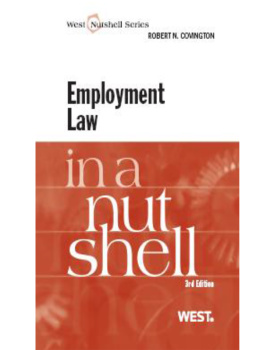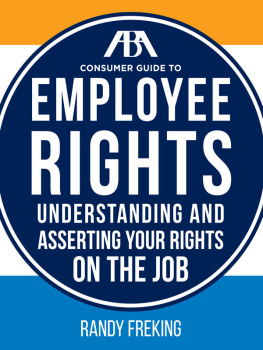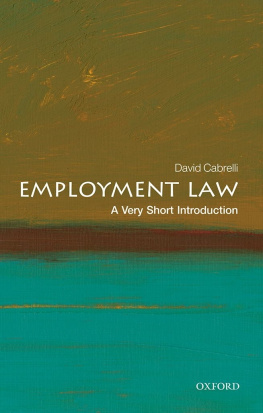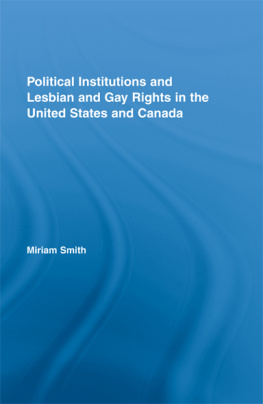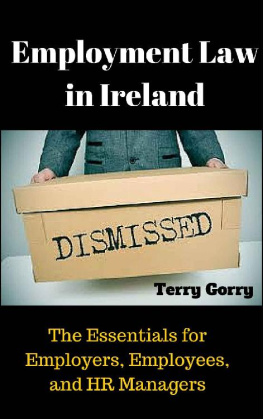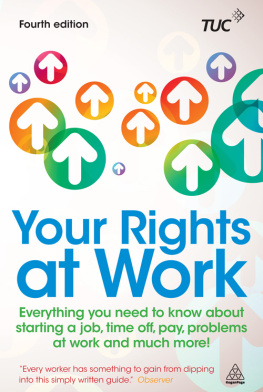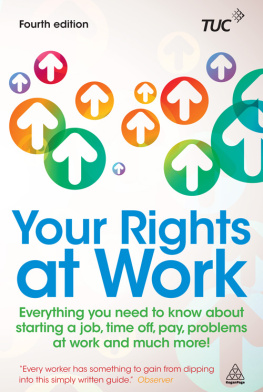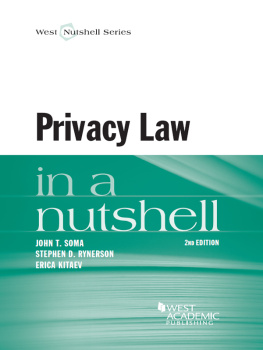Landmarks
Page list

WESTS LAW SCHOOL
ADVISORY BOARD
___________
JESSE H. CHOPER
Professor of Law and Dean Emeritus,
University of California, Berkeley
JOSHUA DRESSLER
Professor of Law, Michael E. Moritz College of Law,
The Ohio State University
YALE KAMISAR
Professor of Law, University of San Diego
Professor of Law Emeritus, University of Michigan
MARY KAY KANE
Professor of Law, Chancellor and Dean Emeritus,
University of California,
Hastings College of the Law
LARRY D. KRAMER
Dean and Professor of Law, Stanford Law School
JONATHAN R. MACEY
Professor of Law, Yale Law School
ARTHUR R. MILLER
University Professor, New York University
Professor of Law Emeritus, Harvard University
GRANT S. NELSON
Professor of Law, Pepperdine University
Professor of Law Emeritus, University of California, Los Angeles
A. BENJAMIN SPENCER
Associate Professor of Law,
Washington & Lee University School of Law
JAMES J. WHITE
Professor of Law, University of Michigan
I
EMPLOYMENT LAW
IN A NUTSHELL
THIRD EDITION
By
ROBERT N. COVINGTON
Professor of Law
Vanderbilt University

Mat # 40760215
II
Thomson Reuters created this publication to provide you with accurate and authoritative information concerning the subject matter covered. However, this publication was not necessarily prepared by persons licensed to practice law in a particular jurisdiction. Thomson Reuters does not render legal or other professional advice, and this publication is not a substitute for the advice of an attorney. If you require legal or other expert advice, you should seek the services of a competent attorney or other professional.
Nutshell Series, In a Nutshell and the Nutshell Logo are trademarks registered in the U.S. Patent and Trademark Office.
COPYRIGHT 1995 WEST PUBLISHING CO.
West, a Thomson business, 2002
2009 Thomson Reuters
610 Opperman Drive
St. Paul, MN 55123
18003139378
Printed in the United States of America
ISBN: 9780314195401
III
PREFACE
___________
When Kurt Decker and I launched the first edition of this short book in 1995, we identified our audience as including three groups:
Readers with little, if any, prior knowledge of employment law, seeking an overview of the field.
Students in employment law courses in undergraduate, business or law schools who are looking for an introduction and study aid.
More sophisticated readers whose usual subject matter interests lie outside employment law, but who find themselves working with a problem in the area and want a springboard from which to do further research.
For the benefit of that third group, the book includes a relatively larger number of case citations than usual for a Nutshell, though I have attempted to be more restrained in this edition when addressing issues on which there are many state-to-state variations.
We have been aided by many over the course of three editions. Patrick Paul, now of the Arizona bar, Erich Rhynhart, now corporate counsel in Boston, Mary Ann Miranda, and others who have provided truly valuable research assistance. The librarians at the Alyne Queener Massey Law Library IV have been helpful as always. That there are not far more errors in spelling and the like is largely due to the efforts of an extraordinary secretary, Janis Stewart.
This edition contains relatively less new material than the second, because the pace of change since 2002 has been somewhat slower than in earlier decades. In part this reflects the realities of politics at the federal level, both the deregulatory stance of the White House and the number of years of divided government in which the ability of the Congress to override vetoes was limited. In part, however, it is probably a reflection of the fact that many earlier changes were of the sort that take a while to digest. The at will doctrine changes, for example, were hard to categorize for a time; now most of the states are refining those changes in an incremental way. The language of many of the discrimination statutes was general in nature, and the courts have had some difficulty in discerning just what the Congress had in mind about some matters. Thus we get amendments, such as the Lilly Ledbetter Fair Pay Act, intended to overturn the interpretation the Supreme Court gave some of that general language.
I continue very much to miss the continued collaboration of Kurt Decker, whose untimely death during preparation of the second edition brought V that to a close. I hope he would approve of the changes in organization and content in this edition.
ROBERT N. COVINGTON
Nashville
May 2009
*
VII
This Book Is Dedicated To
Paula and Hilary
Proverbs 31:29
And To The Memory Of
Kurt H. Decker
19462000
*
LXIII
EMPLOYMENT LAW
IN A NUTSHELL
THIRD EDITION
*
IX
OUTLINE
___________
X
XI
XII
XIII
XIV
XV
XVI
XVII
XVIII
XIX
XX
CHAPTER 1
THE DEVELOPING LAW OF EMPLOYMENT
A. INTRODUCTION
The financial crisis of 2008 has reminded us once again of the central role employment plays in our economy. High unemployment rates mean lower consumer spending and saving, both essential to a healthy nation. Employee and employer ought to want each other to prosper, it would seem. After all, if the employers business does well, employees can often expect to share in that good fortune. Employers who find themselves with a disgruntled and unhappy workforce soon realize that productivity is down, and labor costs up. In practice, however, conflict between employee and employer is a constant feature of our economic system and social structure. A prospering business firm is likely to want to expand; to get the capital it needs for that, the firm may well try to trim its labor costs, perhaps by lay-offs accompanied by the use of temporary workers working at a lower rate of pay. In the current era, a large number of American employers continue to move production, and thus good jobs, to other countries where wage rates are much lower than in the United States. Employment law is the body of legal rules that seek to deal with this ongoing set of conflicts. Statutes and court decisions reflect a constantly shifting balance between employee and employer making employment law one of the most dynamicand also most politicalof all legal areas. Historically, employment law has been a maze of statutes, common-law doctrines, contract-established rules, and administrative agency findings. Sometimes the decision makers act in harmony, sometimes not. Even within a narrow area, such as defamation or the right of privacy, legislators, courts, administrative agencies and arbitrators often do not all see things the same way.
The employment relationship is more than an income source. In our society, self-worth, dignity, satisfaction, and accomplishment are achieved largely by ones employment responsibilities, performance, and rewards. Because of this, employees regularly seek to have a voice in determining their wages, hours, and terms and conditions of employment. Employees have often achieved these objectives through unionization and collective bargaining. In recent decades, however, the unionized portion of the workforce has been shrinking, and there has been a growing emphasis on legal protection of individual employee rights.

